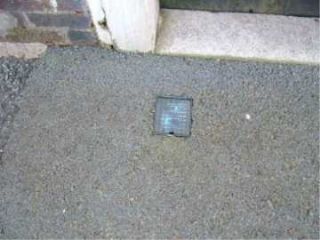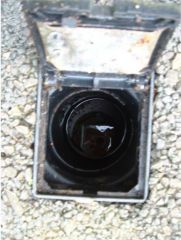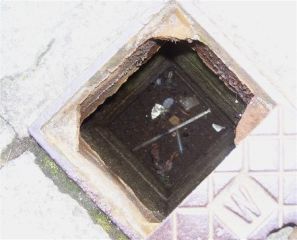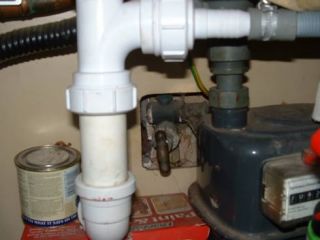Water enters the property via a pipe which is connected to the main water supply, this is called the rising main. This pipe normally has a stopcock outside of the property and a stopcock is normally under the sink although the internal stopcock could be anywhere especially if the building has been extended at some point. The stopcock is simply a valve which will stop the flow of water when closed. To close a stopcock simply turn it clock wise and turn it anti-clockwise to open it. The outside stopcock is very useful and you should familiarise yourself with it as you may need to isolate it quickly in a plumbing emergency.

This is what a stop tap or stopcock cover looks like. There should be one of these at the boundary of your property, it could be at the front or back or in extreme cases at the end of the street. It's always a good idea to know exactly where this stop tap is and test it periodically

To open the cover insert a flat screwdriver and lever the cover upwards, the stopcock is often about 2 feet 6 inches below floor level. Often the stopcock is covered with water, sand or other debris. Water is not a problem but any other obstruction will prevent you from locating the stopcock and so will need cleaning out.

Never put your hand down to turn off the stopcock as it has been known for drug addicts to leave their used needles down there!
The stopcock could be at the front or the rear of the property, in old terraced houses it is not unusual for a stopcock to be located at the end of the street, this normally isolates the whole street when turned off, so be sure to tell your neighbours if you need to isolate the supply there!

A stopcock key will be required to turn the water on and off, these can be purchased for a few pounds or can be easily made.
This video shows how to operate a stopcock-
Stopcock opening/closing | Stop tap opening/closing

The rising main cold water stop cock can be seen here between the gas meter and the waste trap on the sink.
Take a look at the stopcock underneath the kitchen sink and see what pipe is below the stopcock, newer properties have plastic pipes. If a lead pipe is visible (you can tell as they are dark grey, but become shiny if scratched with a key etc.) Then it could be a good Idea to have this pipe replaced. Lead pipes have been known to be detrimental to health and can lead to a excessive build up of lead in the human body, which has been linked to brain damage! If your supply pipe needs replacing you should contact your local water company for advice. Normally you are responsible for the pipe on your property, which means that if you do all the digging and run a new pipe to the property, the water company will come and connect it to the main supply as long as all byelaws have been followed. There are basically only two types of water pipes in houses, either it will be feeding a tap or will be part of the central heating system. Pipes can be plastic or more probably copper, pipes vary in size depending on what they are feeding. The main supply pipe to the property is normally 28mm, the pipes which feeds the boiler and the bath taps are normally 22mm, the pipe that feeds all other taps in the property are 15mm. Small bore pipe is often used for central heating radiators and can be 10mm or even 8mm.



